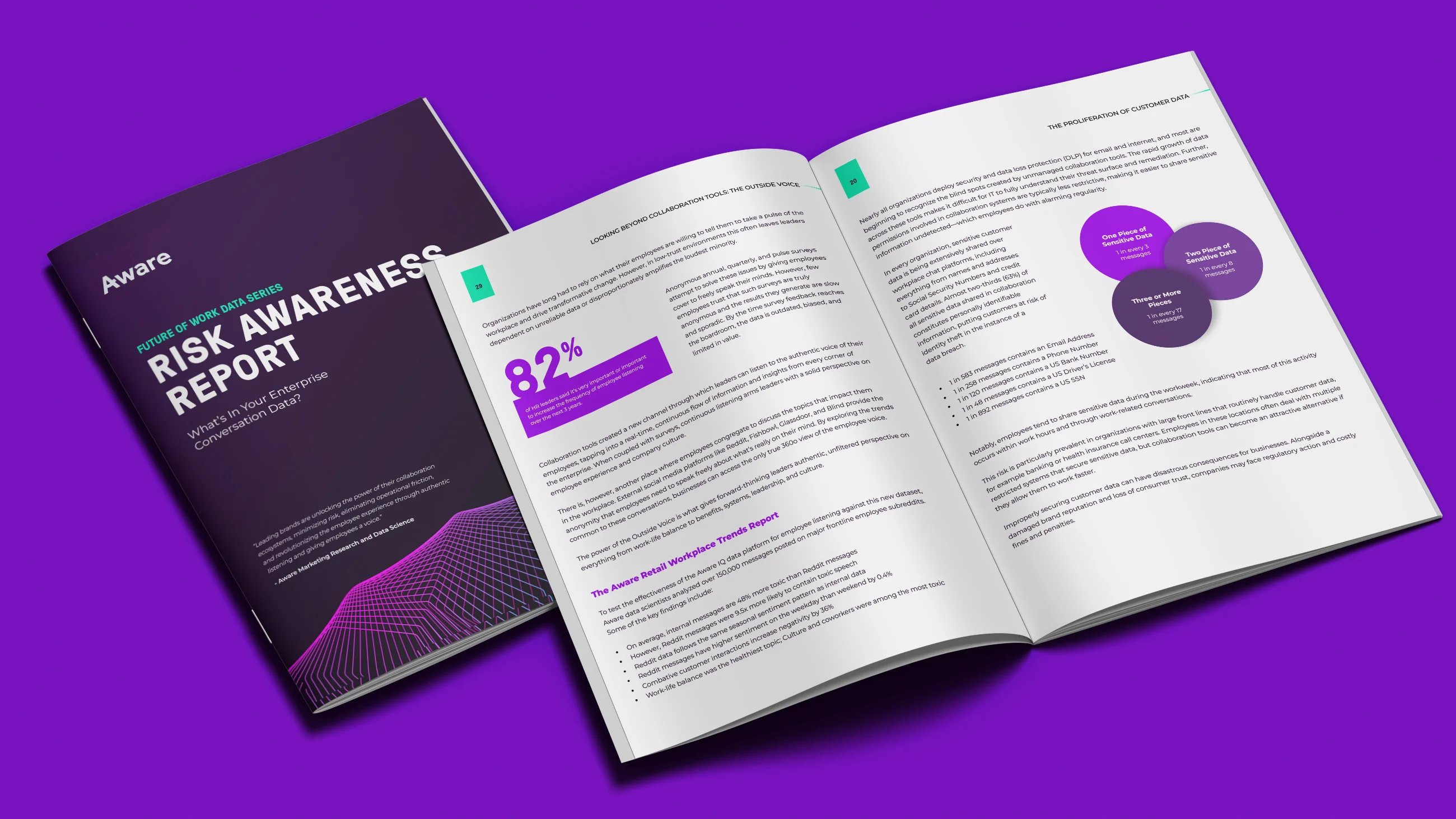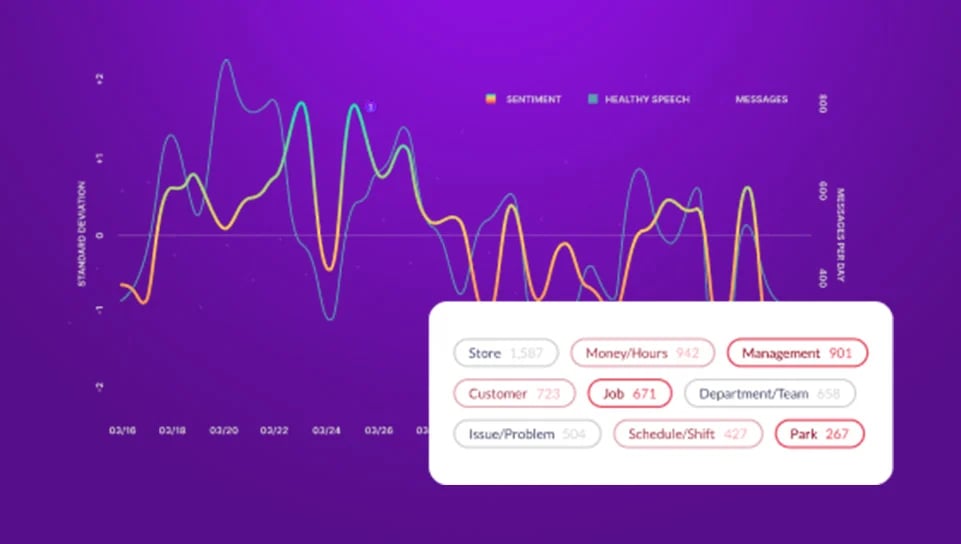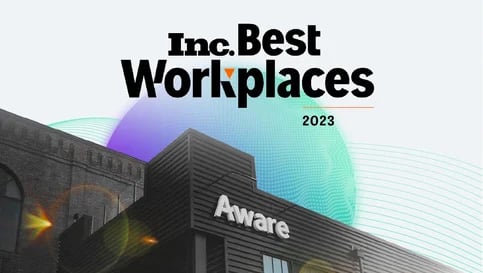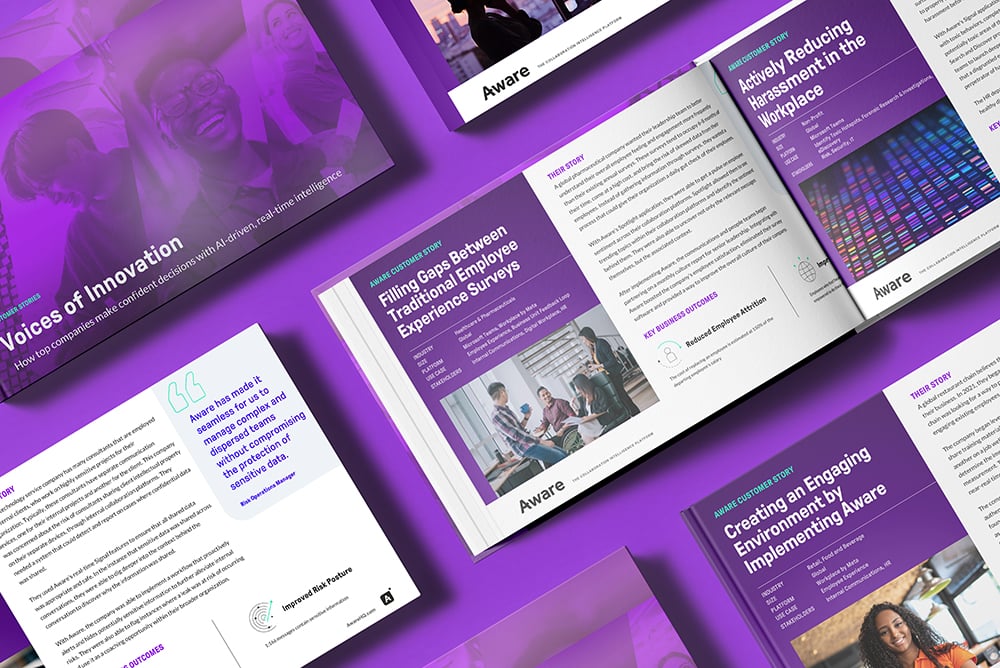BUILT TO UNDERSTAND HUMAN RISK
Protect your business from human behavior risks
Collaboration tools like Slack and Microsoft Teams are the new attack vector for hackers and insider threat actors. Tackle human risks in collaboration from a secure, centralized platform with Aware.
Insider Threats
Monitor user activity using industry-leading sentiment analysis NLP to detect data theft, sabotage, and fraud.
Phishing & Bots
Quickly identify bots, impersonated accounts, malicious links and other cybersecurity risks that threaten your workspace.
Crisis Management
Mitigate the negative consequences of business disruptions, data breaches, change management, and workplace violence.
“Aware has innovative capabilities no other vendors have. There is no learning curve, and it surfaces the data we need, fast!”
— Legal Operations

WHY AWARE
The visibility you need to protect collaboration tools
Legacy tools weren’t built to understand the complexity of messages, @mentions, emojis, and GIFs in tools like Slack and Teams, leading to security gaps, blind spots, and missing context. Aware was purpose-built to understand, detect, and mitigate human behavior risks in collaboration.
Continuous message ingestion
Aware natively connects to collaboration tools via APIs and webhooks, ensuring continuous ingestion with no downtime or missing data.
AI analysis trained on your data
Customized workflows use NLP sentiment analysis normalized for your unique digital environment to detect more anomalies faster with fewer false positives.
Customizable alert workflows
Decide how and where to receive alerts and automate remediation by connecting to existing workflows and coaching employees in real time.
Secure, centralized data management
Protect your collaboration data with enterprise-grade security, including audit logs, role and data-based access control, BYOK, encryption in transit and at rest, and more.
.png?width=775&height=627&name=Content-img%20(1).png)
AI ANALYSIS
Surface risks with powerful AI/ML models
Leverage responsible AI/ML models trained to accurately identify security risks in collaboration data.
Code Detection
Password Detection
Sentiment Analysis
Understand emotions behind text, uncovering key employee insights
INTEGRATIONS
Streamline your workflow
With the click of a button, Aware leverages native APIs and webhooks to ingest and analyze data from across collaboration channels.
Extend the value of the platform by integrating Aware's insights into your existing global hold and legal solutions with RSMF-ready exports and workflow APIs.
Learn more

Risk Awareness Report
Learn more about how employees take risks in collaboration with this report, based on Aware's analysis of 6.6 billion real collaboration messages.

Human Behavior Risk Analysis
Aware's data scientists explored the unique complexities of controlling for human behavior—and the risks you face if you ignore the dangers.
-1.webp?width=1920&height=1080&name=Aware-Webinar-PeoplePerimeter-ResourceImageThumbnail%20(1)-1.webp)
Insider Threats in Collaboration
Renowned infosec experts discuss the challenges of spotting insider risks in collaboration and explore strategies to manage them.

Targeted Social Engineering
Spear phishing attacks are on the rise, and nowhere is the risk greater than in digital comms tools. Learn how Aware can help you win the battle.

Insider Risk Management
Malicious and negligent insiders can compromise data, damage the company reputation, and leave businesses exposed to legal and regulatory action. Learn how to manage these risks now.

What's In Your Data?
Discover how your employees communication in collaboration tools with this free, customized report.
Questions? We're here to help
Everything you need to know about the Aware platform.
What are collaboration tools?
Any tool that enables employees to work together is a kind of collaboration tool. This included dedicated collaboration tools like Slack and Microsoft Teams, enterprise social media platforms like Microsoft Viva Engage (formerly Yammer) and Workplace from Meta, and frontline management tools such as WorkJam. Many other tools also have collaboration features built in, such as Zoom (via Zoom Team Chat) and Google Drive.
What is forensic research and investigation?
Forensic search is a process that involves the use of forensic techniques to search conversations and collect electronic data that may be used as evidence in internal or external investigations. The process of conducting forensic research and investigations begins with identifying the electronic data that may be relevant, usually based on custodian, data, location, and data type. Within collaboration datasets, this data has historically proven difficult to access, but Aware’s automated search functionality brings forensic research to conversations in Slack, Teams, Zoom, and more.
What is federated search?
Organizations use federated search to investigate multiple databases or sources simultaneously and present the results from a single pane of glass. Federated search is particularly useful when searching lots of data or information stored in multiple databases. As over 90% of organizations use at least two collaboration tools (Slack, Teams, Zoom, etc.), federated search from Aware enables investigations into all locations simultaneously.
What are the challenges of performing eDiscovery in collaboration data?
Collaboration tools enable a range of features that make eDiscovery more complicated to perform. For example, collaboration messages can occur in public and private groups or direct messages. This hinders an investigator’s ability to search chat history because a user may have posted in locations that are not readily visible. To search collaboration messages effectively usually requires the use of a third-party tool. However, if that tool does not capture in real time a complete record of all revisions and deletions, spoilation is easy because custodians can always edit or remove their messages.
How can companies perform early case assessment using collaboration data?
Early case assessment (ECA) is an eDiscovery process that helps legal teams make informed decisions about how to approach a case by identifying key information to understand the scope and merits of a case and estimate potential costs. ECA can also help legal teams identify potential risks and opportunities, such as data privacy or regulatory compliance issues, and develop strategies to mitigate those risks. To approach early case assessment efficiently, investigators must be able to search collaboration messages and surface all relevant content and context. This requires permissions to search all messages, including private and direct messages. Full administrator privileges and/or a third-party eDiscovery platform that plugs into the collaboration tools are typically required to enable early case assessment in collaboration.
What kinds of eDiscovery investigations does Aware support in collaboration?
Aware enables investigators to conduct any kind of eDiscovery investigation with federated search for collaboration messages from a centralized archive that contains a complete record of revisions and deletions, captured in real time.
What file types and eDiscovery tools does Aware export to?
Aware exports eDiscovery and early case assessment results to .pdf, .dat, .csv and RSMF formats along with .txt files of every message and text base file. These exports are compatible with all major eDiscovery software, enabling legal teams to analyze collaboration search results according to their usual workflows.
What does the Aware eDiscovery process look like?
Aware ingests collaboration messages from all major tools across the enterprise environment, then normalizes and infuses the data with AI/ML metadata insights designed for the nuances of collaboration. This ensures no loss of context and a complete, defensible record of all messages, including revisions and deletions. From the Aware platform, investigators can conduct federated search of collaboration messages within all tools simultaneously. Searches may be initiated by a range of variables, including custodian, location, message type, date and time, and other factors. Results can then be narrowed by enhanced insights such as sentiment or toxicity. This reduces the time to discovery by producing the most relevant results, delivered with complete context for better understand of who, what, where, when, how, and why.
How does Aware enable faster eDiscovery in collaboration?
Performing eDiscovery in collaboration presents several challenges. Varying permissions regarding message visibility make it harder to surface a complete record of all chat messages. Custodians retain control of their messages after sending, meaning they can edit or delete what they wrote, even months afterward. This increases the likelihood of spoilation. And legacy eDiscovery tools cannot process non-standard message features such as emojis and gifs, leading to missing context. Aware solves for all these problems by ingesting collaboration messages in real time into a centralized archive built for the nuances of collaboration data. This reduces time to discovery and empowers faster eDiscovery search by producing only the most relevant results, without loss of context.
What other use cases does Aware support in addition to eDiscovery in collaboration?
The Aware data platform uses industry-leading natural language processing (NLP) capabilities to analyze collaboration conversations and infuse them with AI-powered metadata that provides the context business leaders need to protect their organizations and support the employee experience. Using Aware’s proprietary technology, organizations can retain control of information governance, retention, compliance adherence, insider threat hunting, and more across the entire collaboration ecosystem from a single, centralized platform.








